Maui's Most Famous mountain
Maui's Most Famous mountain

Rise above the rest with a hike up Diamond Head, where stunning panoramic views of Honolulu await!
Duis efficitur, neque id egestas blandit, arcu lorem commodo justo, non aliquam arcu nulla et libero. Link inside text, massa quis molestie venenatis, erat enim faucibus sapien, eget elementum risus sapien vel turpis. Fusce vestibulum suscipit sem, vel gravida neque maximus ut. Duis dignissim enim at lorem auctor consequat. Ut neque dui, dapibus nec molestie quis, facilisis nec odio.Duis efficitur, neque id egestas blandit, arcu lorem commodo justo, non aliquam arcu nulla et libero. Link inside text, massa quis molestie venenatis, erat enim faucibus sapien, eget elementum risus sapien vel turpis. Fusce vestibulum suscipit sem, vel gravida neque maximus ut. Duis dignissim enim at lorem auctor consequat. Ut neque dui, dapibus nec molestie quis, facilisis nec odio.
1. Diamond Head: Hawaii's Iconic Volcanic Crater and Popular Tourist Destination
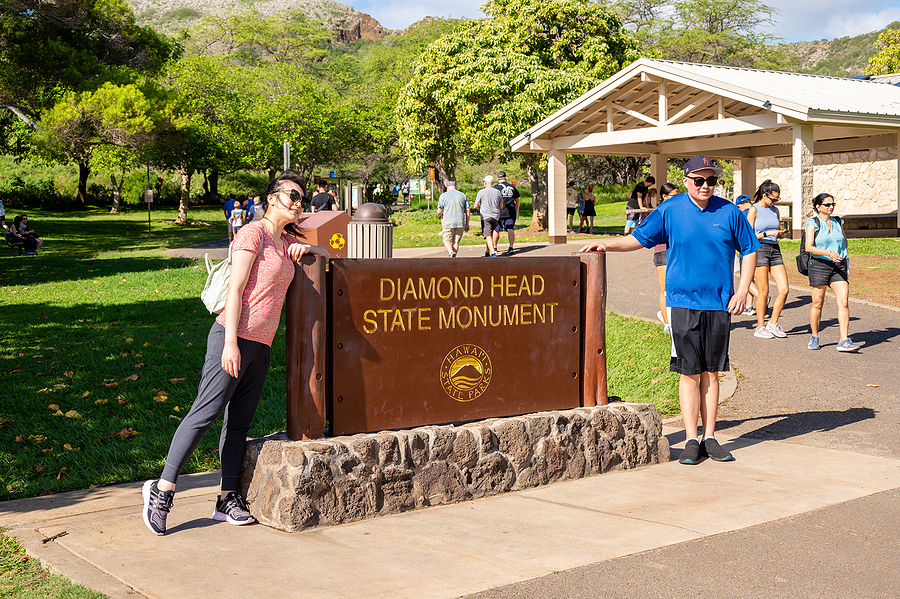
Honolulu, Hawaii - tourists at the Diamond Head entrance sign at the Diamond Head State Monument.
Diamond Head, or Lē'ahi in Hawaiian, is one of the most iconic natural landmarks in Hawaii and an essential stop for anyone visiting the island of Oahu. Located on the southeastern coast of Oahu near Honolulu, this volcanic tuff cone offers stunning panoramic views, unique historical experiences, and a glimpse into Hawaii's rich geological and cultural history. Diamond Head is not only a must-visit tourist attraction in Hawaii but also a significant geological feature that has become a symbol of the island's natural beauty. In this comprehensive guide, we will explore the formation, history, hiking trails, and significance of Diamond Head, as well as provide tips for making the most of your visit.
The Geological History of Diamond Head Crater
The formation of Diamond Head Crater dates back about 300,000 years as part of the Honolulu Volcanic Series, a group of volcanic eruptions that shaped many of Oahu's distinctive geological features. Unlike shield volcanoes such as Mauna Loa and Mauna Kea, Diamond Head is classified as a tuff cone, a type of volcanic landform created by a single explosive eruption. When hot magma from below the Earth's surface came into contact with groundwater, it caused a steam explosion, sending ash and fine volcanic material into the air. These materials settled and solidified, forming the steep, sloping walls of the crater that we see today.
Diamond Head's unique profile, characterized by its ridged and rugged edges, was further sculpted by trade winds, erosion, and weathering over thousands of years. The crater itself spans about 3,520 feet in diameter and covers approximately 475 acres. The summit of Diamond Head rises to a height of 762 feet above sea level, providing breathtaking views of the Pacific Ocean, Waikiki, and downtown Honolulu.
Why Is It Called Diamond Head?
The name "Diamond Head" was given by British sailors in the early 19th century who mistook the shiny calcite crystals found on the crater's slopes for diamonds. Although these crystals had no actual value, the name "Diamond Head" stuck and has become the most recognized name for the volcanic feature. In Hawaiian, the crater is known as Lē'ahi, which translates to "brow of the tuna." According to legend, the Hawaiian goddess Hi'iaka, sister of the volcano goddess Pele, named it Lē'ahi because the summit resembled the dorsal fin of a tuna fish ('ahi) breaking the surface of the ocean.
Diamond Head State Monument: A Popular Tourist Attraction
Today, Diamond Head is preserved as part of the Diamond Head State Monument, one of the most visited natural attractions in Hawaii. The monument is managed by the Hawaii State Parks and offers visitors a chance to explore the crater's unique landscape, hike the famous Diamond Head Trail, and learn about the history and geology of the area through educational exhibits. The monument encompasses the entire crater, providing a mix of recreational activities, historical landmarks, and educational resources.
Hiking the Diamond Head Trail

View from Diamond Head summit on Honolulu, with unidentified people. The crater is a popular destination mainly for the view on the city and the coast
The Diamond Head Crater Trail is one of the most popular hiking trails on Oahu, attracting thousands of visitors each year. The trail, which is about 1.6 miles round trip, takes hikers from the crater floor to the summit, offering spectacular views along the way. Although the hike is relatively short, it is considered moderate in difficulty due to its steep ascent, switchbacks, and staircases.
The trail begins at the parking area within the Diamond Head State Monument. From there, hikers make their way up a series of switchbacks that gradually climb the interior slope of the crater. Along the way, you'll pass through several tunnels and climb steep staircases, including a 99-step staircase and a narrow spiral staircase that leads to an observation platform at the summit.
What to Expect on the Diamond Head Trail
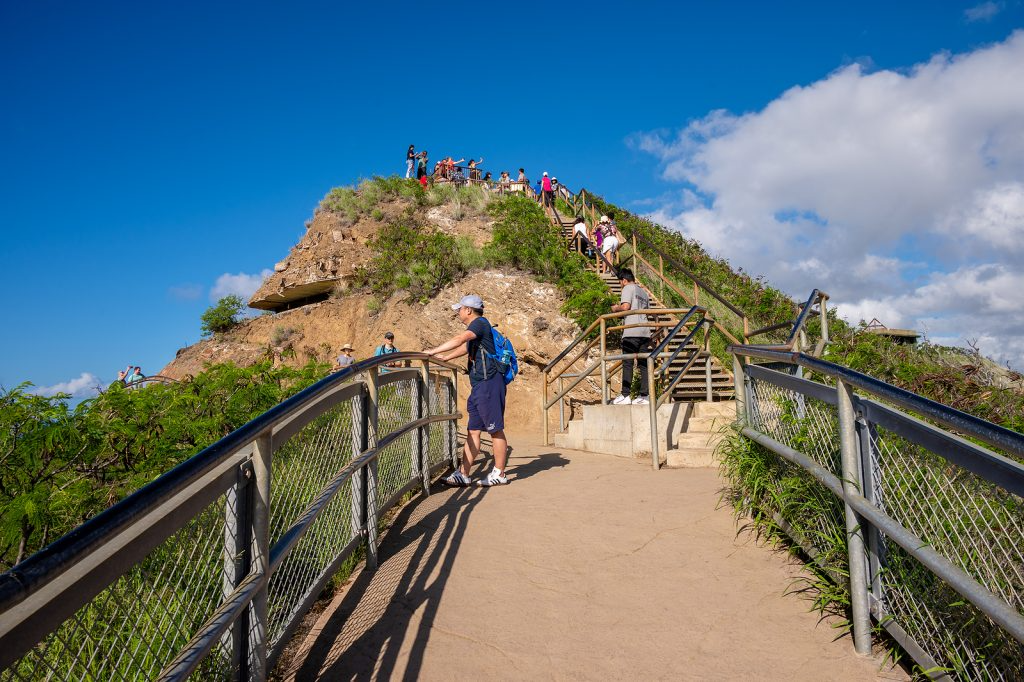
Honolulu, Hawaii - Tourists hiking down the Diamond Head lookout trail.
The hike to the summit of Diamond Head typically takes about 1 to 2 hours round trip, depending on your pace and the number of stops you make to take in the views. The trail offers little shade, so it's important to be prepared for sun exposure. Here are some key features of the Diamond Head Trail:
Trailhead and Start of the Hike: The trailhead is located near the visitor center and parking lot. The initial section of the trail is a gradual incline, offering views of the crater's interior.
Tunnel Sections: The trail includes two tunnels carved into the volcanic rock. These tunnels can be narrow and dark, adding a sense of adventure to the hike.
Staircases and Summit Ascent: The most challenging part of the hike is the series of steep staircases near the summit. The 99-step staircase is particularly notable, followed by a spiral staircase that leads to the final observation platform.
Summit Views: The reward for reaching the summit is a panoramic view that stretches from Waikiki Beach to Koko Head. On clear days, you can see as far as the Ko'olau Mountain Range and the blue expanse of the Pacific Ocean.
Tips for Hiking Diamond Head
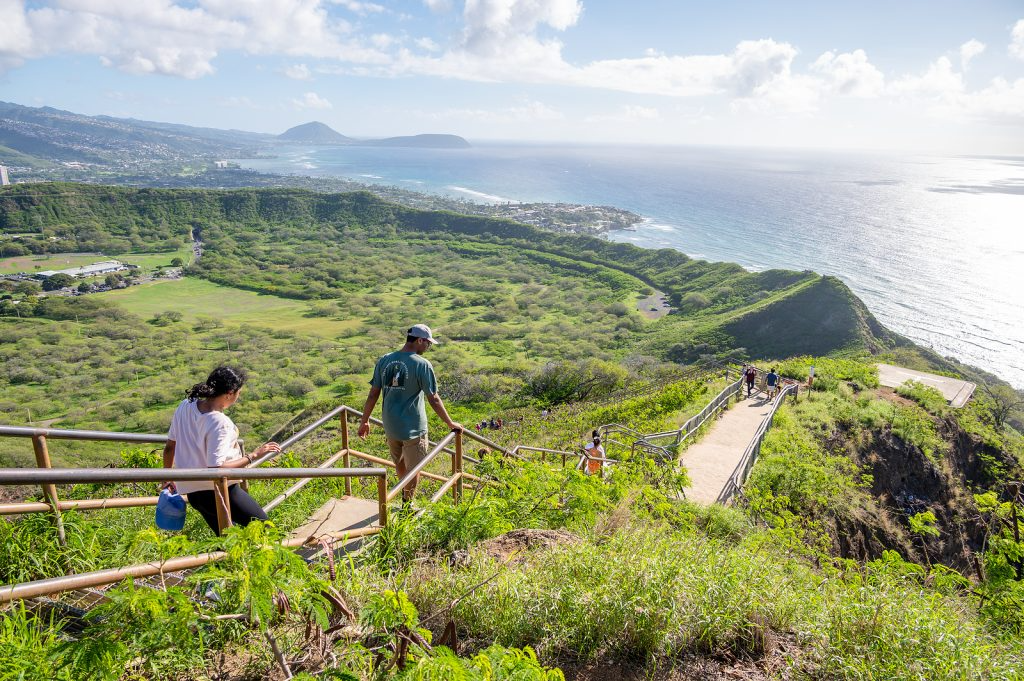
Tourists hiking on the Diamond Head lookout trail.
To make the most of your hiking experience at Diamond Head, consider the following tips:
Arrive Early: The trail can get crowded, especially during peak tourist hours. Arriving early in the morning helps you avoid the crowds and enjoy cooler temperatures.
Bring Water and Sun Protection: There is little shade on the trail, and the Hawaiian sun can be intense. Bring plenty of water, wear sunscreen, and consider wearing a hat or sunglasses.
Wear Proper Footwear: The trail can be rocky and uneven in places. Sturdy shoes with good grip are recommended to ensure a safe and comfortable hike.
Take Your Time: Although the hike is relatively short, the steep sections can be challenging. Take breaks as needed and enjoy the views along the way.
The Military History of Diamond Head
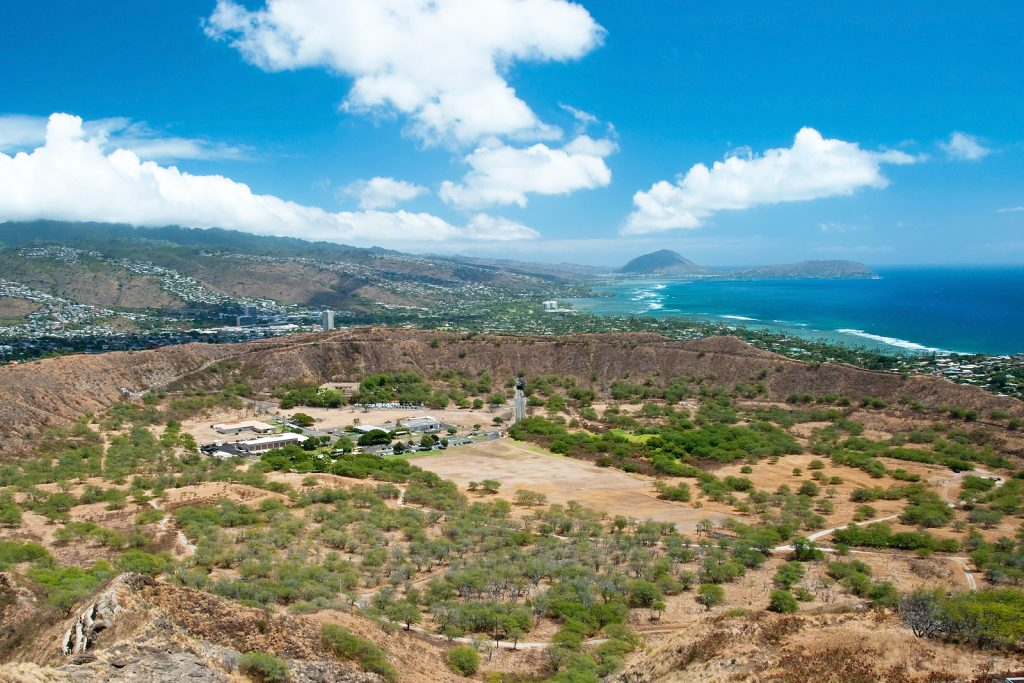
Diamond Head State Monument Park Trail close Honolulu on Oahu Hawaii
In addition to its natural beauty, Diamond Head has a rich military history. In the early 20th century, the U.S. military recognized the strategic importance of the crater's high vantage point overlooking Honolulu and the surrounding coastline. In 1908, Diamond Head was designated as a military reservation, and extensive fortifications were built inside the crater as part of Hawaii's coastal defense system.
The military constructed a series of bunkers, artillery batteries, and tunnels, many of which are still visible along the hiking trail today. These fortifications were designed to protect the island from potential naval attacks, although they were never used in combat. The Fire Control Station at the summit was an observation post used to direct military fire from coastal defense guns. The military presence at Diamond Head continued through World War II, and remnants of the fortifications remain a popular historical attraction for visitors.
The Diamond Head Lighthouse
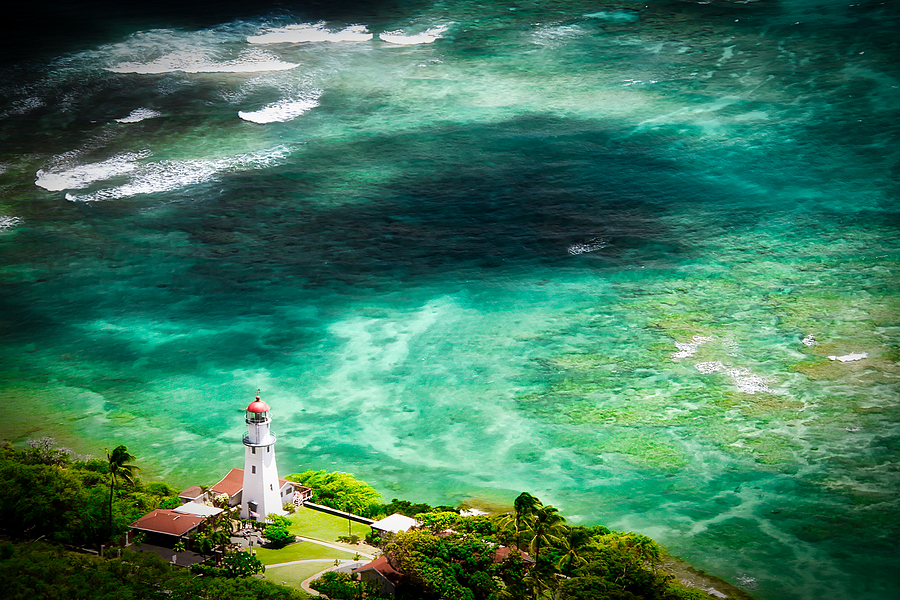
Looking down on the Diamond Head lighthouse in Honolulu, Hawaii.
Another key feature of Diamond Head is the Diamond Head Lighthouse, located on the southern slopes of the crater. Built in 1917, the lighthouse serves as a navigational aid for ships approaching Honolulu Harbor. It stands at a height of 55 feet and has been listed on the National Register of Historic Places. Although the lighthouse is not open to the public, it can be seen from lookout points along the coastal road and is a favorite spot for photographers, especially at sunset.
The Diamond Head Lighthouse is also known for its role in the Transpac Yacht Race, one of the oldest and most prestigious ocean races in the world. The race, which begins in California and finishes in Hawaii, uses the lighthouse as a key navigational marker as competitors approach the finish line off the coast of Oahu
The Cultural Significance of Diamond Head
For native Hawaiians, Diamond Head, or Lē'ahi, holds deep cultural and spiritual significance. It was traditionally considered a sacred site, associated with the Hawaiian goddess Pele and the god Kāne, who were believed to have used the crater as a place of worship and rituals. The summit was used for navigational purposes and as a vantage point for observing celestial events. Ancient Hawaiians also built heiau (temples) along the slopes of Diamond Head, which were used for religious ceremonies and offerings to the gods.
Today, the cultural heritage of Diamond Head is celebrated through interpretive displays and educational programs at the Diamond Head State Monument. Visitors can learn about the geological history, cultural legends, and military significance of the crater, gaining a deeper appreciation for its role in Hawaiian history.
Visiting Diamond Head: What You Need to Know
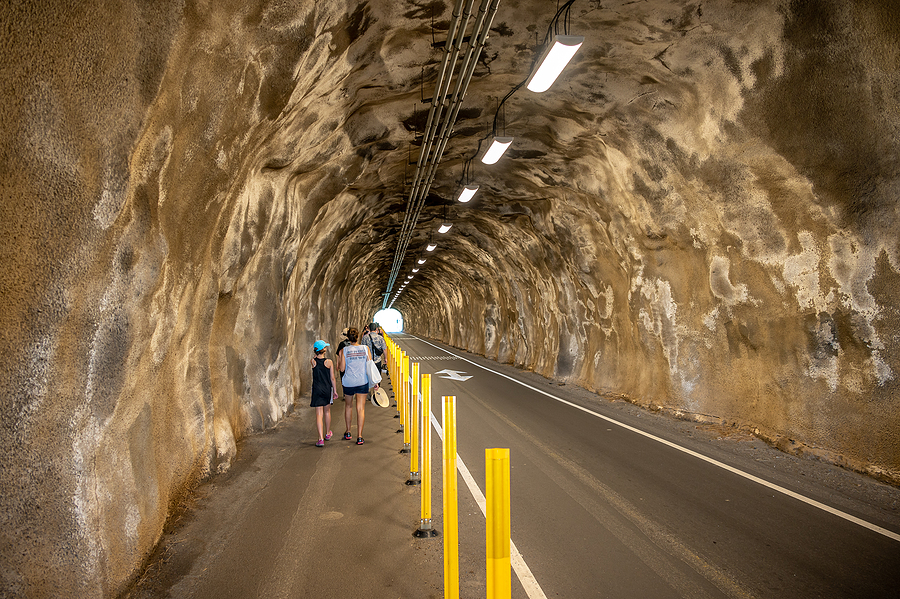
Tourists walking through the tunnel to the Diamond Head hike starting point.
The Diamond Head State Monument is open daily from 6 a.m. to 6 p.m., with the last entry allowed at 4:30 p.m. There is a small entrance fee for visitors, which helps fund the preservation and maintenance of the park. The monument includes a visitor center with restrooms, informational displays, and a gift shop where you can purchase souvenirs.
Parking can be limited, especially during peak hours, so it's recommended to arrive early or consider using public transportation or ride-sharing services. The area is also accessible by foot from Waikiki, making it a convenient option for those staying in nearby hotels.
Conclusion
Diamond Head is much more than just a scenic landmark; it is a testament to Hawaii's geological forces, a symbol of its military history, and a sacred site deeply rooted in the cultural traditions of the Hawaiian people. Whether you're hiking the Diamond Head Trail for panoramic views, exploring the remnants of military bunkers, or simply taking in the natural beauty of the crater, a visit to Diamond Head is a quintessential part of any trip to Oahu.
As one of the most recognizable natural features in Hawaii, Diamond Head continues to captivate visitors from around the world with its breathtaking vistas, fascinating history, and enduring cultural significance. For adventure seekers, history enthusiasts, and those simply looking to enjoy the outdoors, Diamond Head offers a unique and unforgettable experience, making it a must-visit destination on the island of Oahu.
2. The Ko'olau Mountains: Oahu's Iconic Volcanic Range
The Ko'olau Mountains, often referred to as the "backbone of Oahu," form one of the most prominent and recognizable natural features of the island of Oahu, Hawaii. This majestic mountain range, with its steep cliffs, verdant valleys, and cascading waterfalls, stretches along the eastern coast of the island and offers some of the most spectacular scenery in the Hawaiian Islands. The Ko'olau Mountains are the result of ancient volcanic activity and provide a wealth of recreational opportunities for visitors, including hiking, sightseeing, and exploring the lush rainforests. In this comprehensive guide, we will explore the geological history, cultural significance, hiking trails, and unique ecosystems of the Ko'olau Mountains, offering a deeper understanding of why this natural wonder is a must-visit destination on Oahu.
Geological Formation of the Ko'olau Mountains
The Ko'olau Mountain Range is the remnant of a massive shield volcano that formed about 2.5 million years ago. The Ko'olau Volcano was originally one of the largest volcanoes on Oahu, towering thousands of feet above sea level. Over millions of years, volcanic activity ceased, and the shield volcano underwent extensive erosion and collapse, creating the steep, jagged cliffs that define the range today.
A significant geological event, known as the Ko'olau Landslide, occurred about 1.5 million years ago, resulting in a massive collapse of the eastern side of the volcano. This landslide caused the entire seaward flank of the volcano to slide into the ocean, leaving behind the dramatic cliffs and valleys that characterize the Ko'olau Mountains. The evidence of this landslide can still be seen in the form of underwater debris fields stretching far into the Pacific Ocean.
The Ko'olau Mountains are now an eroded, heavily weathered landscape featuring steep ridges, deep valleys, and sheer cliffs. The Pali Cliffs, one of the most striking features of the range, rise sharply above the eastern coast of Oahu, offering breathtaking views of the island's windward side. These cliffs, carved by millions of years of rain and wind, are a testament to the powerful forces of erosion that shaped the Hawaiian islands.
The Cultural Significance of the Ko'olau Mountains
The Ko'olau Mountains hold deep cultural and spiritual significance for the native Hawaiian people. In Hawaiian mythology, the mountains are associated with the gods and are considered sacred. The name "Ko 'olau" means "windward" in Hawaiian, reflecting the constant trade winds that blow from the northeast, bringing moisture and rain to the windward side of the island.
The Ko'olau Mountains are also tied to many Hawaiian legends and stories. One of the most famous legends involves the battle of Nu 'uanu, a historic conflict that took place in 1795 between the forces of King Kamehameha I and the Oahu chiefs. The battle culminated at the Nu'uanu Pali, a steep cliff overlooking the windward coast. Kamehameha's forces drove the Oahu warriors to the edge of the Pali, where many were forced over the cliffs, marking a decisive victory in Kamehameha's quest to unify the Hawaiian Islands.
The valleys of the Ko'olau Mountains, such as Ka'a'awa Valley and Kahana Valley, were once important centers of agriculture for ancient Hawaiians. The fertile soil and abundant freshwater streams provided ideal conditions for growing kalo (taro), a staple crop of the Hawaiian diet. Today, these valleys are home to cultural sites, ancient heiau (temples), and remnants of the traditional Hawaiian lifestyle.
Hiking in the Ko'olau Mountains
The Ko'olau Mountains offer some of the best hiking opportunities on Oahu, with trails that cater to all levels of experience. From easy, family-friendly hikes to challenging ridge trails, the range provides a variety of outdoor adventures for those looking to explore its natural beauty.
Nu'uanu Pali Lookout
The Nu'uanu Pali Lookout is one of the most popular destinations in the Ko'olau Mountains, offering sweeping views of the windward coast, including Kaneohe, Kailua, and the lush valleys below. The lookout is accessible by car via the Pali Highway (Route 61) and is a great spot for photography and sightseeing. The strong trade winds that blow through the pass add a dramatic element to the experience.
Visitors can also explore the Old Pali Road, a historic trail that was once the main route connecting Honolulu to the windward side of the island. The trail takes hikers through dense rainforest, past waterfalls, and along steep cliffs, offering a glimpse into the island's history and natural beauty.
Olomana Trail (Three Peaks Trail)
For those seeking a more challenging hike, the Olomana Trail, also known as the Three Peaks Trail, offers a thrilling experience. The trail is about 4.5 miles round trip and involves steep climbs, narrow ridges, and spectacular views of the Ko 'olau Mountains and the windward coast. The hike is named for its three distinct peaks: Olomana, Paku'i, and Ahiki. The first peak, Olomana, provides the most accessible viewpoint, while the second and third peaks require more advanced climbing skills and are recommended only for experienced hikers.
Ka'au Crater Trail
The Ka'au Crater Trail is a loop hike that takes adventurers through a lush rainforest, along streambeds, and past several beautiful waterfalls before ascending to the rim of the Ka'au Crater, an ancient volcanic crater within the Ko'olau Range. The hike is about 7 miles round trip and offers a mix of scenic views, challenging terrain, and unique geological features. From the crater rim, hikers can enjoy panoramic views of Honolulu, the Ko'olau Mountains, and the Pacific Ocean.
Kuliouou Ridge Trail
The Kuliouou Ridge Trail is a popular ridge hike that offers stunning views of both the windward and leeward sides of Oahu. The trail is about 5 miles round trip and features a mix of shaded forest paths and open ridgelines. As hikers ascend, they are treated to breathtaking vistas of the Ko'olau Mountains, the island's coastline, and the surrounding ocean. The summit provides a rewarding view of the windward side, including Waimanalo and Kaneohe Bay.
Ecosystems and Wildlife of the Ko'olau Mountains
The Ko'olau Mountains are home to a diverse range of ecosystems, from coastal forests to high-elevation cloud forests. The windward side of the range receives abundant rainfall, creating a lush, tropical environment that supports a variety of native plants and animals.
Native Flora
The forests of the Ko'olau Mountains are dominated by native Hawaiian plants, including the 'ōhi'a lehua, with its distinctive red blossoms, and the koa tree, known for its strong, durable wood. The cloud forests near the summit of the range are home to rare plants like the Hawaiian lobelioids, which are adapted to the wet, misty conditions.
Native Fauna
The Ko'olau Mountains provide habitat for several species of native birds, including the 'apapane, the 'amakihi, and the endangered 'ō'ū. The streams and rivers that flow from the mountains support native freshwater fish and shrimp, such as the 'o'opu, a type of goby that can climb waterfalls.
Waterfalls of the Ko'olau Mountains
The abundant rainfall in the Ko'olau Mountains feeds numerous waterfalls, which cascade down the steep cliffs and flow into the valleys below. Some of the most famous waterfalls include:
Maunawili Falls: A popular waterfall located along the Maunawili Trail, offering a swimming hole at its base.
Lulumahu Falls: A hidden gem accessible via a short, unmarked trail through the rainforest.
Likeke Falls: A two-tiered waterfall located near the Old Pali Highway, known for its scenic beauty.
Tips for Visiting the Ko'olau Mountains
When exploring the Ko'olau Mountains, visitors should be prepared for changing weather conditions and challenging terrain. Here are some tips:
Check the Weather: The Ko'olau Mountains can be rainy and misty, especially in the afternoon. Start hikes early and bring a rain jacket.
Wear Proper Footwear: Trails can be steep and muddy. Sturdy hiking shoes with good grip are essential.
Respect the Land: The mountains are a sacred place in Hawaiian culture. Stay on marked trails and leave no trace.
Conclusion
The Ko'olau Mountains offer a breathtaking combination of natural beauty, cultural history, and outdoor adventure. From hiking along scenic ridges to exploring hidden waterfalls and learning about Hawaiian legends, a visit to the Ko'olau Mountains is a journey into the heart of Oahu's wild and untamed landscape. Whether you are a nature enthusiast, a history buff, or an adventure seeker, the Ko'olau Mountains provide an unforgettable experience that captures the spirit of Hawaii.